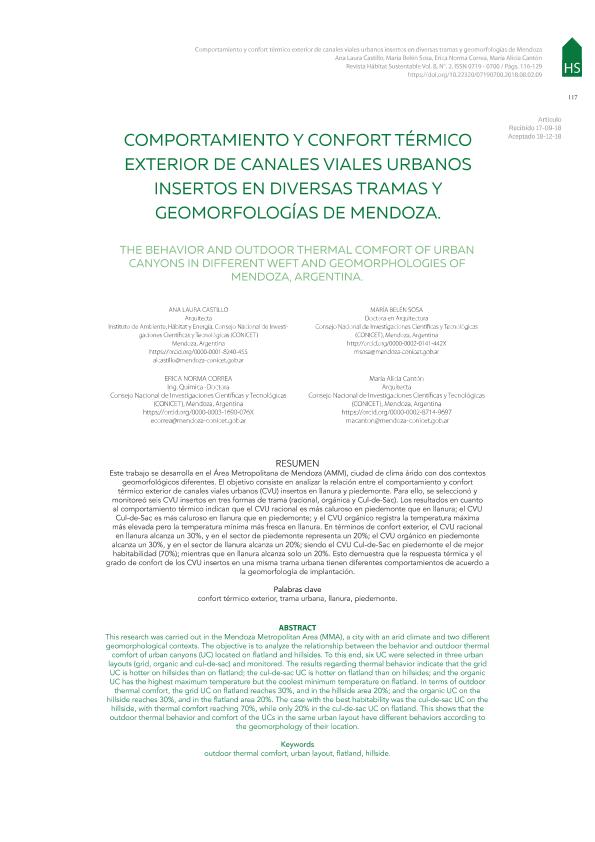Mostrar el registro sencillo del ítem
dc.contributor.author
Castillo, Ana Laura

dc.contributor.author
Sosa, María Belén

dc.contributor.author
Correa Cantaloube, Erica Norma

dc.contributor.author
Canton, Maria Alicia

dc.date.available
2019-11-27T18:51:56Z
dc.date.issued
2018-12
dc.identifier.citation
Castillo, Ana Laura; Sosa, María Belén; Correa Cantaloube, Erica Norma; Canton, Maria Alicia; Comportamiento y confort térmico exterior de canales viales urbanos insertos en diversas tramas y geomorfologías de Mendoza; Universidad del Bío-Bío; Hábitat Sustentable; 8; 2; 12-2018; 117-129
dc.identifier.issn
0719-0700
dc.identifier.uri
http://hdl.handle.net/11336/90686
dc.description.abstract
Este trabajo se desarrolla en el Área Metropolitana de Mendoza (AMM), ciudad de clima árido con dos contextos geomorfológicos diferentes. El objetivo consiste en analizar la relación entre el comportamiento y confort térmico exterior de canales viales urbanos (CVU) insertos en llanura y piedemonte. Para ello, se seleccionó y monitoreó seis CVU insertos en tres formas de trama (racional, orgánica y Cul-de-Sac). Los resultados en cuanto al comportamiento térmico indican que el CVU racional es más caluroso en piedemonte que en llanura; el CVU Cul-de-Sac es más caluroso en llanura que en piedemonte; y el CVU orgánico registra la temperatura máxima más elevada pero la temperatura mínima más fresca en llanura. En términos de confort exterior, el CVU racional en llanura alcanza un 30%, y en el sector de piedemonte representa un 20%; el CVU orgánico en piedemonte alcanza un 30%, y en el sector de llanura alcanza un 20%; siendo el CVU Cul-de-Sac en piedemonte el de mejor habitabilidad (70%); mientras que en llanura alcanza solo un 20%. Esto demuestra que la respuesta térmica y el grado de confort de los CVU insertos en una misma trama urbana tienen diferentes comportamientos de acuerdo a la geomorfología de implantación.
dc.description.abstract
This research was carried out in the Mendoza Metropolitan Area (MMA), a city with an arid climate and two different geomorphological contexts. The objective is to analyze the relationship between the behavior and outdoor thermal comfort of urban canyons (UC) located on flatland and hillsides. To this end, six UC were selected in three urban layouts (grid, organic and cul-de-sac) and monitored. The results regarding thermal behavior indicate that the grid UC is hotter on hillsides than on flatland; the cul-de-sac UC is hotter on flatland than on hillsides; and the organic UC has the highest maximum temperature but the coolest minimum temperature on flatland. In terms of outdoor thermal comfort, the grid UC on flatland reaches 30%, and in the hillside area 20%; and the organic UC on the hillside reaches 30%, and in the flatland area 20%. The case with the best habitability was the cul-de-sac UC on the hillside, with thermal comfort reaching 70%, while only 20% in the cul-de-sac UC on flatland. This shows that the outdoor thermal behavior and comfort of the UCs in the same urban layout have different behaviors according to the geomorphology of their location.
dc.format
application/pdf
dc.language.iso
spa
dc.publisher
Universidad del Bío-Bío

dc.rights
info:eu-repo/semantics/openAccess
dc.rights.uri
https://creativecommons.org/licenses/by-nc-sa/2.5/ar/
dc.subject
CONFORT TÉRMICO EXTERIOR
dc.subject
TRAMA URBANA
dc.subject
LLANURA
dc.subject
PIEDEMONTE
dc.subject
OUTDOOR THERMAL COMFORT
dc.subject
URBAN LAYOUT
dc.subject
FLATLAND
dc.subject
HILLSIDE
dc.subject.classification
Otras Ciencias de la Tierra y relacionadas con el Medio Ambiente

dc.subject.classification
Ciencias de la Tierra y relacionadas con el Medio Ambiente

dc.subject.classification
CIENCIAS NATURALES Y EXACTAS

dc.title
Comportamiento y confort térmico exterior de canales viales urbanos insertos en diversas tramas y geomorfologías de Mendoza
dc.title
The behavior and outdoor thermal comfort of urban canyons in different weft and geomorphologies of Mendoza, Argentina
dc.type
info:eu-repo/semantics/article
dc.type
info:ar-repo/semantics/artículo
dc.type
info:eu-repo/semantics/publishedVersion
dc.date.updated
2019-10-18T18:31:27Z
dc.journal.volume
8
dc.journal.number
2
dc.journal.pagination
117-129
dc.journal.pais
Chile

dc.journal.ciudad
Concepción
dc.description.fil
Fil: Castillo, Ana Laura. Consejo Nacional de Investigaciones Científicas y Técnicas. Centro Científico Tecnológico Conicet - Mendoza. Instituto de Ambiente, Hábitat y Energía; Argentina
dc.description.fil
Fil: Sosa, María Belén. Consejo Nacional de Investigaciones Científicas y Técnicas. Centro Científico Tecnológico Conicet - Mendoza. Instituto de Ambiente, Hábitat y Energía; Argentina
dc.description.fil
Fil: Correa Cantaloube, Erica Norma. Consejo Nacional de Investigaciones Científicas y Técnicas. Centro Científico Tecnológico Conicet - Mendoza. Instituto de Ambiente, Hábitat y Energía; Argentina
dc.description.fil
Fil: Canton, Maria Alicia. Consejo Nacional de Investigaciones Científicas y Técnicas. Centro Científico Tecnológico Conicet - Mendoza. Instituto de Ambiente, Hábitat y Energía; Argentina
dc.journal.title
Hábitat Sustentable
dc.relation.alternativeid
info:eu-repo/semantics/altIdentifier/doi/http://dx.doi.org/10.22320/07190700.2018.08.02.09
dc.relation.alternativeid
info:eu-repo/semantics/altIdentifier/url/http://revistas.ubiobio.cl/index.php/RHS/article/view/3369
Archivos asociados
